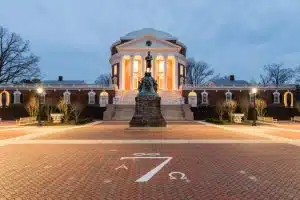Comparing Bowdoin College vs the University of Virginia
If you’re considering colleges, it can be overwhelming to choose the right one. Whether you’re a high school student looking to apply for college or a parent researching for your child, you want to find the best fit. There are many factors to consider, such as location, campus environment, academic programs, faculty and student ratio, admission requirements, job prospects after graduation, and more. In this article, we’ll be comparing Bowdoin College vs the University of Virginia.
History and Background of Bowdoin College and the University of Virginia
Bowdoin College was founded in 1794 in Brunswick, Maine, by James Bowdoin III, who was a governor of Massachusetts and a signer of the U.S. Constitution. The college has a long history of intellectual and cultural achievements, including alumni like Nathaniel Hawthorne, Henry Wadsworth Longfellow, Admiral Robert Peary, and Joshua Chamberlain. Today, Bowdoin College is a private liberal arts college that offers 33 academic majors and enrolls approximately 1,800 students.
The University of Virginia was founded in 1819 in Charlottesville, Virginia, by Thomas Jefferson, who was a Founding Father, principal author of the Declaration of Independence, and the third President of the United States. The university was the first to establish a school of law and a school of medicine in the United States. Today, the University of Virginia is a public research university with 11 schools and offers over 121 undergraduate and graduate programs to approximately 24,000 students.
Bowdoin College has a strong commitment to sustainability and environmental stewardship. The college has implemented various initiatives to reduce its carbon footprint, including using renewable energy sources, promoting sustainable transportation, and reducing waste. Bowdoin College has also been recognized for its efforts in sustainability, receiving accolades such as being named one of the greenest colleges in the United States by the Princeton Review.
The University of Virginia has a rich history of academic excellence and innovation. The university has produced numerous Nobel laureates, Pulitzer Prize winners, and Rhodes Scholars. In addition, the university is home to several prestigious research centers and institutes, including the Miller Center for Public Affairs, the Batten School of Leadership and Public Policy, and the Center for Advanced Study of Teaching and Learning.
Location and Campus Environment
Bowdoin College is located in Brunswick, Maine, which is a small town near the coast. The college has a beautiful campus that covers over 200 acres and is known for its Gothic architecture. The college has a strong commitment to sustainability and has implemented a number of programs to reduce its carbon footprint.
The University of Virginia is located in Charlottesville, Virginia, which is a small city in central Virginia. The campus is built around Thomas Jefferson’s original design and features beautiful neoclassical architecture. The university has also implemented sustainability programs and was ranked first in the state for campus sustainability.
In addition to its commitment to sustainability, Bowdoin College also has a strong focus on community service. The college offers numerous opportunities for students to engage in service projects both on and off campus. Students can participate in programs such as the McKeen Center for the Common Good, which connects students with local organizations and non-profits to address community needs. Bowdoin also has a strong tradition of alumni involvement in service, with many graduates continuing to give back to their communities long after graduation.
Academic Programs Offered by Bowdoin College and the University of Virginia
Bowdoin College offers 33 academic majors, ranging from traditional liberal arts subjects to interdisciplinary programs like environmental studies and computer science. The college has a strong focus on undergraduate research and provides many opportunities for students to conduct research alongside faculty members.
The University of Virginia offers over 121 undergraduate and graduate programs through 11 schools, including liberal arts, engineering, business, law, and medicine. The university has a strong emphasis on interdisciplinary studies and offers programs like global sustainability and neuroscience.
Both Bowdoin College and the University of Virginia offer study-abroad programs for their students. Bowdoin College has partnerships with over 100 programs in 40 countries, allowing students to study in locations like Spain, Japan, and South Africa. The University of Virginia has its own study abroad center, which offers programs in over 70 countries. Students can choose from semester-long programs, summer programs, and even short-term programs during winter break or spring break.
Faculty and Student Ratio Comparison
The faculty-to-student ratio is an important factor to consider when choosing a college. Bowdoin College has a 9:1 student-to-faculty ratio, which allows for a personalized educational experience and more opportunities for students to work closely with their professors. The University of Virginia has a 15:1 student-to-faculty ratio, which is still a low ratio compared to other large universities.
However, it is important to note that a low faculty-to-student ratio does not necessarily guarantee a better education. Other factors, such as the quality of professors, curriculum, and resources, also play a significant role in the overall educational experience. It is important for students to consider all of these factors when making their college decision.
Admission Requirements and Acceptance Rates
Bowdoin College has a highly selective admission process, with an acceptance rate of around 10%. The college requires students to submit an application, standardized test scores (SAT or ACT), high school transcripts, essays, and letters of recommendation.
The University of Virginia is also selective, with an acceptance rate of around 23%. The university requires students to submit an application, standardized test scores (SAT or ACT), high school transcripts, essays, and letters of recommendation.
In addition to the required materials, both Bowdoin College and the University of Virginia also consider extracurricular activities, leadership experience, and community involvement in their admissions decisions. Bowdoin College values a student’s commitment to community service and social responsibility, while the University of Virginia looks for students who have demonstrated a passion for learning and intellectual curiosity.
Campus Life: Residential Life, Extracurricular Activities, and Social Scene
Bowdoin College is known for its sense of community, and the college offers a variety of residential options, including traditional residence halls, theme houses, and social houses. The college has over 100 student-led clubs and organizations, ranging from community service to the arts. The college also has a strong athletic program and is a member of NCAA Division III.
The University of Virginia also has a strong sense of community, and the university offers a variety of residential options, including traditional residence halls, suites, and apartments. The university has over 700 student clubs and organizations, ranging from academic to social activities. The university has a strong athletic program and is a member of NCAA Division I.
Both Bowdoin College and the University of Virginia offer a vibrant social scene. Bowdoin College has a variety of events throughout the year, including concerts, dances, and cultural celebrations. The college also has a strong tradition of hosting social events in its residence halls, such as movie nights and game nights. The University of Virginia also has a lively social scene, with events ranging from concerts and parties to cultural festivals and art exhibits. The university also has a strong Greek life presence, with over 30 fraternities and sororities on campus.
Athletics: Sports Teams, Facilities, and Achievements
Bowdoin College has a strong tradition in athletics, with 31 varsity teams competing in NCAA Division III. The college has won numerous championships in sports like field hockey, soccer, and tennis. The college has state-of-the-art athletic facilities, including a fitness center, a swimming pool, and tennis courts.
The University of Virginia has a strong athletic program, with 27 varsity teams competing in NCAA Division I. The university has won numerous championships in sports like basketball, lacrosse, and soccer. The university has state-of-the-art athletic facilities, including a football stadium, a basketball arena, and a swimming pool.
In addition to its varsity teams, Bowdoin College also offers a variety of club and intramural sports for students to participate in. These include ultimate frisbee, rugby, and volleyball. The college also has a strong commitment to fitness and wellness, offering classes and programs in yoga, Pilates, and personal training.
The University of Virginia is known for its strong academic programs, but it also has a thriving sports culture. The university has a dedicated fan base, known as the “Wahoo Nation,” who support the teams at every game. The university also has a strong commitment to community service, with many of the athletes participating in volunteer work and service projects in the local area.
Job Prospects After Graduation from Bowdoin College and the University of Virginia
Bowdoin College has a strong focus on preparing students for careers after graduation, and the college has a career planning center that provides resources like resume and cover letter reviews, career counseling, and networking opportunities. According to a survey conducted by the college, approximately 42% of graduates go on to work in business and finance, 20% in education, and 16% in government and non-profit.
The University of Virginia also has a strong focus on career readiness, and the university has a career center that provides resources like career counseling, job and internship postings, and networking opportunities. According to a survey conducted by the university, approximately 44% of graduates go on to work in business, 18% in healthcare, and 17% in education.
However, it is important to note that job prospects after graduation can vary depending on the major or field of study. For example, at Bowdoin College, graduates with majors in economics and computer science have a higher likelihood of finding employment in the business and finance sector, while graduates with majors in education and environmental studies are more likely to work in the non-profit sector.
Similarly, at the University of Virginia, graduates with majors in nursing and public health have a higher likelihood of finding employment in the healthcare sector, while graduates with majors in business and engineering are more likely to work in the private sector.
Alumni Network of Bowdoin College vs. University of Virginia: Strengths and Weaknesses
Bowdoin College has a supportive alumni network that provides career advice, mentoring, and networking opportunities. The college has over 25,000 alumni located around the world, and many of them are active in alumni events and activities.
The University of Virginia also has a strong alumni network, which provides various programs like mentorship, networking, and career services to its graduates. The university has over 250,000 alumni located around the world, and many of them are active in alumni events and activities.
One of the strengths of Bowdoin College’s alumni network is its close-knit community. The college has a small student body, which fosters strong relationships between students and faculty. This sense of community extends to the alumni network, where graduates often feel a strong connection to their alma mater and are eager to support current students and fellow alumni.
On the other hand, the University of Virginia’s alumni network is known for its vast size and reach. With over 250,000 alumni, graduates have access to a wide range of resources and connections. However, this large size can also make it difficult for individual alumni to feel a sense of community and connection with their fellow graduates.
Tuition Fees, Financial Aid, Scholarships, and Student Debt
Bowdoin College has a tuition fee of approximately $54,000 per year, and the college offers financial aid packages to approximately 50% of its students. The college also offers merit-based scholarships to students who demonstrate exceptional academic or extracurricular achievements.
The University of Virginia has a tuition fee of approximately $52,000 per year for out-of-state students, and the university offers financial aid packages to approximately 48% of its students. The university also offers merit-based scholarships to students who demonstrate exceptional academic or extracurricular achievements.
Student Diversity at Bowdoin College vs. University of Virginia
Bowdoin College has a diverse student body, with students from 44 states and 22 countries. Approximately 44% of students self-identify as students of color, and approximately 11% of students are international students.
The University of Virginia also has a diverse student body, with students from all 50 states and 148 countries. Approximately 33% of students self-identify as students of color, and approximately 10% of students are international students.
Despite the similarities in diversity between Bowdoin College and the University of Virginia, there are some notable differences. Bowdoin College has a higher percentage of students who identify as LGBTQ+ at approximately 10%, while the University of Virginia has a lower percentage at approximately 5%. Additionally, Bowdoin College has a higher percentage of first-generation college students at approximately 16%, while the University of Virginia has a lower percentage at approximately 12%.
Both institutions have made efforts to increase diversity and inclusion on their campuses. Bowdoin College has implemented a test-optional policy to increase access for underrepresented students, while the University of Virginia has established a Center for Diversity in Engineering to support underrepresented students pursuing STEM fields. These initiatives demonstrate a commitment to creating a more diverse and inclusive campus community.
Research Opportunities at Bowdoin College vs. University of Virginia
Bowdoin College provides many research opportunities for undergraduate students, with over 300 students participating in research each year alongside their professors. The college has also established the Bowdoin Scientific Station in the Gulf of Maine, which provides an opportunity for students to conduct marine research.
The University of Virginia is a research-oriented university, and the university provides many research opportunities to undergraduate as well as graduate students. The university has established various research centers, including the Center for Global Health, the Data Science Institute, and the Brain Institute.
Additionally, Bowdoin College offers a unique program called the Coastal Studies Center, which allows students to conduct research on the Maine coast and islands. The center provides access to various ecosystems, including salt marshes, rocky intertidal zones, and mudflats, and students can conduct research on topics such as marine ecology, environmental science, and sustainability.
Study Abroad Programs Offered by Bowdoin College vs. University of Virginia
Bowdoin College offers many study abroad programs, and approximately 60% of students study abroad at some point during their college career. The college has established exchange programs with universities around the world, including programs in France, Spain, Japan, and China.
The University of Virginia also offers many study abroad programs, and approximately 34% of students study abroad at some point during their college career. The university has established exchange programs with universities around the world, including programs in Italy, Spain, Japan, and Korea.
In addition to exchange programs, Bowdoin College also offers faculty-led programs that allow students to study abroad with Bowdoin professors. These programs are designed to provide students with a unique academic experience that combines classroom learning with cultural immersion. Some of the faculty-led programs offered by Bowdoin College include a marine biology program in the Bahamas, a history program in Greece, and a literature program in Ireland.
Similarly, the University of Virginia offers faculty-led programs that allow students to study abroad with UVA professors. These programs are designed to provide students with a unique academic experience that combines classroom learning with cultural immersion. Some of the faculty-led programs offered by the University of Virginia include a politics program in London, a business program in Shanghai, and a music program in Vienna.
Conclusion
As you can see, there are many similarities and differences between Bowdoin College and the University of Virginia. Both institutions have a strong academic reputation, provide many opportunities for students to get involved, and offer various resources for career development. When deciding which college to attend, it’s important to consider your personal preferences and priorities, such as location, campus size, academic programs, and career goals. We hope this article has provided you with a comprehensive comparison of Bowdoin College and the University of Virginia.
However, there are some notable differences between the two institutions. Bowdoin College is a small liberal arts college located in Maine, while the University of Virginia is a large public research university located in Virginia. Bowdoin College has a student-to-faculty ratio of 9:1, which allows for more personalized attention and smaller class sizes. On the other hand, the University of Virginia has a wider range of academic programs and research opportunities due to its larger size and resources.
Ultimately, the decision of which college to attend is a personal one and depends on individual preferences and goals. It’s important to visit each campus, talk to current students and faculty, and research the academic programs and resources offered. We hope this article has provided you with a starting point for your college search and wish you the best of luck in your decision-making process.










































